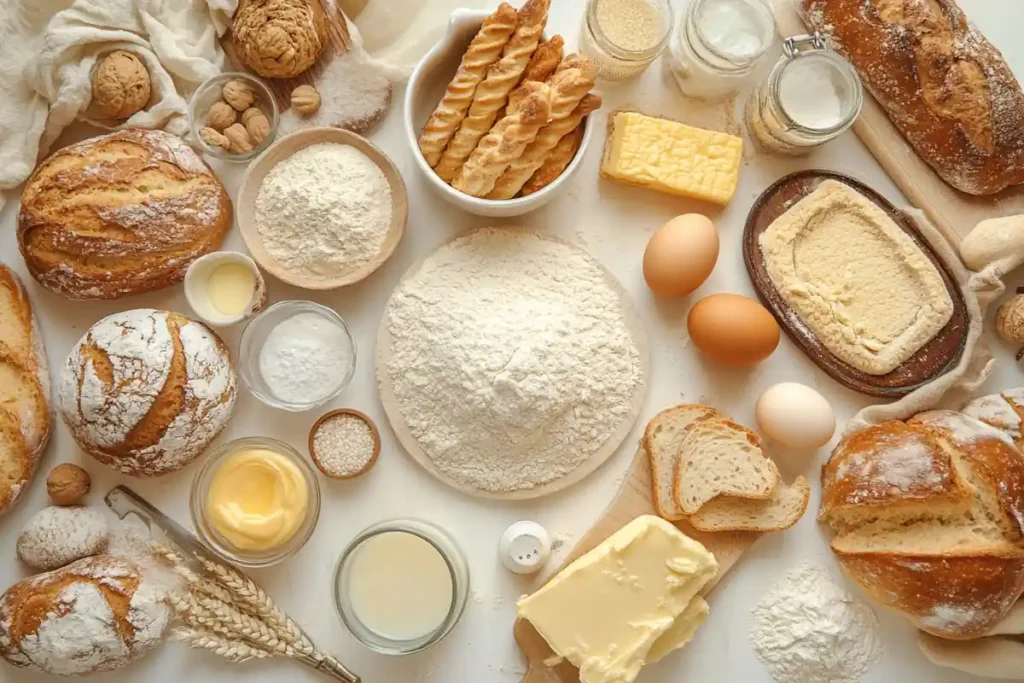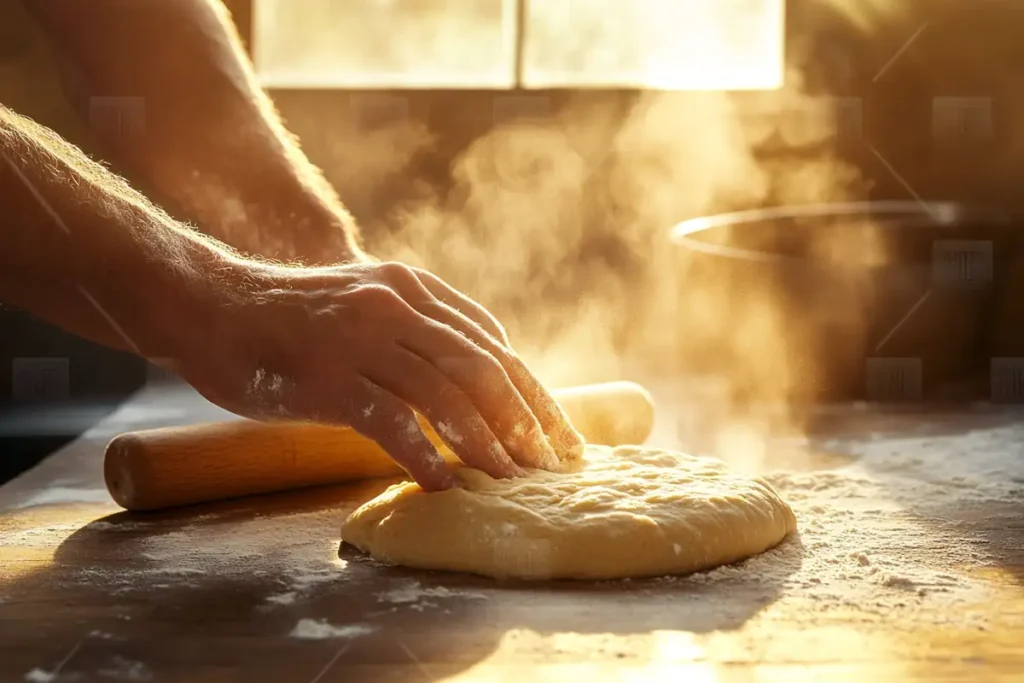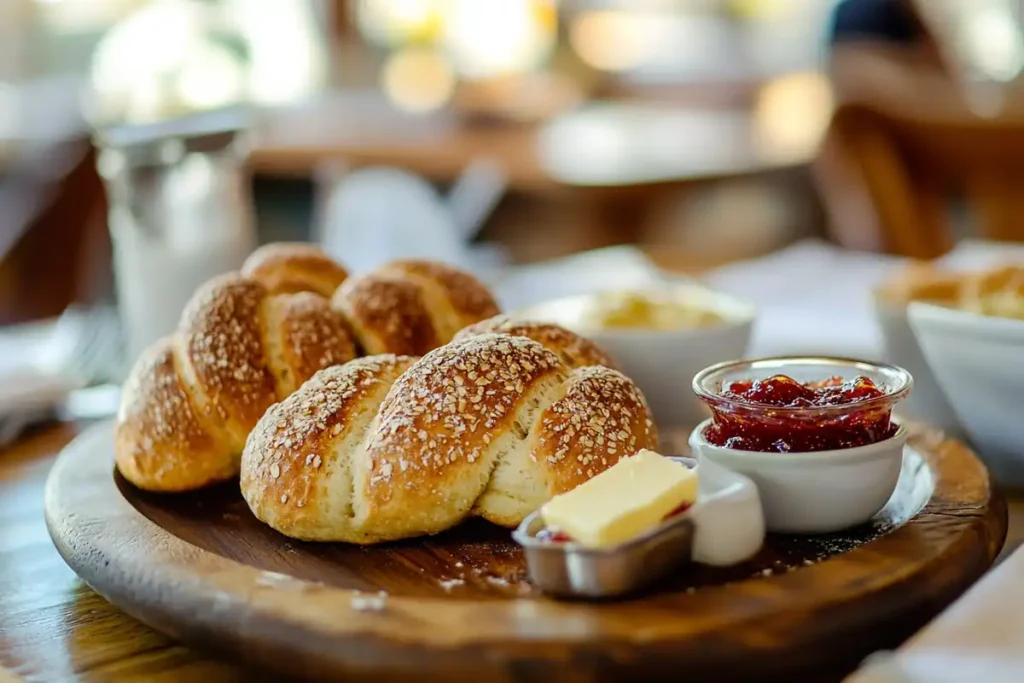If you’ve ever dreamt of creating a Swiss pastry masterpiece, you’re in the right place. The gipfeli recipe offers the perfect blend of simplicity and tradition. This guide will take you step by step through the process, from understanding its origins to creating your own flaky, golden-brown gipfeli at home. Whether you’re a baking newbie or a seasoned chef, there’s something magical about crafting these crescent-shaped delights. So, let’s roll up our sleeves and get started!
Introduction to Gipfeli
What is Gipfeli?
Gipfeli, sometimes referred to as the Swiss croissant, is a cherished part of Swiss culinary heritage. Unlike its French counterpart, the gipfeli boasts a denser texture and a slightly less buttery flavor, offering a unique twist to the classic crescent-shaped pastry. You’ll often find this delicacy paired with coffee for a quintessential Swiss breakfast experience.
But what truly sets the gipfeli apart? It’s all in the dough. With its flaky yet firm consistency, gipfeli strikes the perfect balance between indulgence and simplicity, making it a favorite across Swiss households and bakeries.
History and Origin of Gipfeli
The story of gipfeli begins with the Austrian kipferl, a crescent-shaped pastry that dates back to the 13th century. The Swiss adopted and refined this pastry over centuries, creating a denser and more practical version to suit their tastes and baking traditions.
Today, gipfeli represents much more than just a pastry. It’s a symbol of Swiss tradition, enjoyed during breakfast or as a midday snack. Each region in Switzerland has its own version, some incorporating fillings like chocolate, cheese, or nuts.
Importance of Gipfeli in Swiss Culture
In Switzerland, gipfeli is more than just a breakfast item. It’s a cultural icon, often shared during family gatherings, work meetings, or leisurely brunches. The distinct aroma of freshly baked gipfeli wafting from bakeries is a morning ritual that awakens Swiss towns and cities.
What’s fascinating is how each Swiss bakery has its own gipfeli recipe, passed down through generations. Whether enjoyed plain or with a side of jam, every bite tells a story of tradition and craftsmanship.
Ingredients and Equipment

Essential Ingredients for Gipfeli
To create authentic gipfeli, you need high-quality, simple ingredients that work harmoniously to achieve that perfect texture and taste. Here’s what you’ll need:
- All-Purpose Flour (500g): Forms the base of the dough and ensures structure.
- Unsalted Butter (250g, cold and cubed): The secret to those flaky layers.
- Active Dry Yeast (10g): Helps the dough rise beautifully.
- Granulated Sugar (50g): Adds a hint of sweetness to the pastry.
- Salt (10g): Enhances flavor and balances the sweetness.
- Whole Milk (250ml, warmed): Activates the yeast and brings the dough together.
- Egg (1, for egg wash): Gives the gipfeli their signature golden-brown shine.
Optional ingredients include fillings like chocolate, jam, or nuts, which can elevate the flavor profile.
Necessary Equipment for Making Gipfeli
Having the right tools can make or break your baking adventure. To ensure your gipfeli turn out just right, keep these essentials handy:
- Mixing Bowl: For combining and mixing the ingredients.
- Rolling Pin: To evenly roll out the dough, ensuring consistent thickness.
- Pastry Cutter or Sharp Knife: Perfect for cutting precise triangles.
- Baking Tray: A flat surface for baking the gipfeli evenly.
- Pastry Brush: Used for applying the egg wash to achieve a glossy finish.
- Cling Wrap: Essential for resting and chilling the dough.
With these ingredients and tools at your disposal, you’re well on your way to mastering this Swiss pastry delight. Remember, precision and patience are key to creating the best results.
Step-by-Step Guide to Making Gipfeli
Preparing the Dough

Creating the dough is the foundation of an excellent gipfeli. Follow these steps carefully to achieve the perfect base:
- Activate the Yeast: In a small bowl, combine the active dry yeast with warm milk (around 37°C or 100°F). Let it sit for about 5 minutes until it becomes frothy—this signals that the yeast is alive and active.
- Combine Dry Ingredients: In a large mixing bowl, whisk together the all-purpose flour, granulated sugar, and salt. This step ensures even distribution of the dry ingredients.
- Incorporate the Butter: Add the cold, cubed butter to the dry mixture. Using your fingertips or a pastry cutter, work the butter into the flour until the mixture resembles coarse crumbs.
- Mix the Wet and Dry Ingredients: Slowly pour the frothy yeast mixture into the flour and butter mixture. Stir until the dough begins to form.
- Knead the Dough: Transfer the dough to a lightly floured surface and knead it for about 8–10 minutes. The dough should become smooth, elastic, and slightly sticky.
- First Rise: Place the dough in a lightly greased bowl, cover it with a damp cloth, and let it rest in a warm place for about 1 hour or until it doubles in size.
Rolling and Folding the Dough
The rolling and folding process is what gives gipfeli their iconic flaky layers. Here’s how to do it:
- Roll Out the Dough: After the first rise, punch down the dough to release air bubbles. Roll it out on a floured surface into a large rectangle about 1 cm thick.
- Incorporate Butter Layers: Place thinly sliced or cubed cold butter evenly across two-thirds of the dough. Fold the unbuttered third over the middle third, then fold the remaining buttered section over the top—like folding a letter.
- Chill the Dough: Wrap the folded dough in cling wrap and place it in the refrigerator for at least 30 minutes. This step allows the butter to firm up, making it easier to work with.
- Repeat Rolling and Folding: Roll out the dough again into a rectangle, perform another letter fold, and chill it for another 30 minutes. Repeat this process two more times.
- Final Chill: After the last fold, wrap the dough and let it rest in the fridge for at least 1 hour (or overnight for better results).
Shaping the Gipfeli
The final step before baking involves shaping your dough into those classic crescent forms:
- Roll the Dough: On a lightly floured surface, roll out the dough into a large rectangle about 0.5 cm thick.
- Cut into Triangles: Using a pastry cutter or sharp knife, divide the dough into long triangles. Aim for a base width of about 8 cm and a height of 15 cm.
- Add Fillings (Optional): If desired, place a small amount of filling (like chocolate or jam) near the base of each triangle.
- Shape the Gipfeli: Starting at the base of each triangle, gently roll it up toward the tip, forming a crescent shape. Place each gipfeli on a baking tray lined with parchment paper, ensuring the tip is tucked underneath to prevent unrolling during baking.
Baking the Perfect Gipfeli
Preparing for Baking
Before you place your gipfeli in the oven, there are a few essential steps to ensure they bake to golden perfection:
- Preheat the Oven: Set your oven to 200°C (390°F). Proper preheating is crucial for even baking.
- Apply the Egg Wash: In a small bowl, whisk together one egg with a tablespoon of water or milk. Using a pastry brush, lightly coat each gipfeli with the egg wash. This step gives them their signature golden shine.
- Let Them Rest: Allow the shaped and brushed gipfeli to sit at room temperature for about 10–15 minutes. This helps them puff slightly before baking.
Baking Process
- Bake Until Golden Brown: Place the tray of gipfeli in the preheated oven. Bake for approximately 15–20 minutes or until they are puffed and golden brown. The exact time may vary depending on your oven, so keep an eye on them during the last few minutes.
- Cool on a Rack: Once baked, remove the gipfeli from the oven and transfer them to a wire rack to cool. This prevents the bottoms from becoming soggy and ensures even cooling.
Tips for Perfect Baking Results
- Spacing Matters: Leave enough space between the gipfeli on the tray to allow for expansion during baking.
- Even Coating: Be sure to brush the egg wash evenly across the surface for consistent browning.
- Check the Oven: Avoid opening the oven door too often, as this can cause temperature fluctuations and affect the rise.
What to Expect from Your Gipfeli
When your gipfeli come out of the oven, they should be:
- Golden Brown: A glossy, golden-brown crust thanks to the egg wash.
- Flaky but Firm: Distinct layers visible on the outside while being slightly dense inside.
- Aromatic: The rich, buttery aroma that fills your kitchen is a hallmark of perfectly baked gipfeli.
Serving Suggestions for Gipfeli

How to Serve Gipfeli
Gipfeli are best enjoyed fresh and warm, straight from the oven. Their flaky texture and buttery flavor make them versatile enough to pair with a variety of accompaniments:
- With Butter and Jam: Spread a thin layer of butter and your favorite jam or marmalade for a classic breakfast treat.
- With Nutella or Chocolate Spread: For those with a sweet tooth, a smear of Nutella adds an indulgent touch.
- Plain with Coffee or Tea: Sometimes, simplicity is best. Pair your gipfeli with a cup of freshly brewed coffee or tea for a delightful snack.
- Savory Fillings: If you’ve made savory gipfeli, serve them with cheese, sliced vegetables, or smoked salmon for a light lunch or appetizer.
Perfect Occasions to Enjoy Gipfeli
Gipfeli are a delightful addition to any meal or gathering. Here are a few occasions where they shine:
- Breakfast or Brunch: Start your day with a warm gipfeli alongside a hot beverage.
- Afternoon Snack: A quick pick-me-up during a busy day.
- Festive Gatherings: Impress your guests with freshly baked gipfeli as part of a holiday spread.
- Picnics: Easy to transport and share, they’re perfect for outdoor outings.
Storage and Reheating Tips
To maintain their flavor and texture, proper storage is essential:
- Storage: Place leftover gipfeli in an airtight container or wrap them tightly in plastic wrap. Store at room temperature for up to two days or freeze for longer storage.
- Reheating: To refresh the crispness, reheat gipfeli in a preheated oven at 180°C (350°F) for about 5 minutes. Avoid using a microwave, as it can make them soggy.
Variations of Gipfeli
Exploring Flavors and Fillings
While traditional gipfeli are delightful on their own, there’s no limit to the creative possibilities when it comes to fillings and variations. Here are some popular options:
- Sweet Fillings:
- Chocolate Chips: Add a handful of chocolate chips to the base of each triangle for a gooey surprise.
- Fruit Jams: Apricot, raspberry, or strawberry jams work beautifully as a filling.
- Almond Paste: Spread a thin layer of almond paste for a rich, nutty flavor.
- Savory Fillings:
- Cheese: Soft cheeses like Brie or cream cheese melt perfectly inside gipfeli.
- Spinach and Feta: Add a touch of Mediterranean flair with this combination.
- Herbs and Garlic Butter: Spread garlic butter infused with fresh herbs for a savory twist.
Shape Variations
Though the crescent shape is traditional, you can experiment with other shapes to suit your preference or occasion:
- Mini Gipfeli: Perfect for snacks or appetizers, simply cut smaller triangles.
- Straight Rolls: Skip the crescent shape and roll the triangles straight for a modern look.
- Twisted Gipfeli: Add a fun twist to the dough before rolling it into shape.
Gipfeli Around the World
Gipfeli shares similarities with several pastries worldwide, but each has its unique touch:
- French Croissant: Lighter, flakier, and more buttery than gipfeli.
- Austrian Kipferl: The predecessor to gipfeli, often denser and less layered.
- Danish Pastry: Sweeter and often filled with custard or fruit.
Experimenting with these variations allows you to appreciate the versatility of gipfeli while exploring global pastry traditions.
Common Mistakes and Pro Tips for Making Gipfeli
Avoiding Common Mistakes
Even seasoned bakers can encounter pitfalls when making gipfeli. Here’s what to watch out for:
- Skipping the Chill Time: Skipping or shortening the refrigeration steps can cause the butter layers to melt, ruining the pastry’s flaky texture. Always chill the dough between folds.
- Overworking the Dough: Kneading too much or handling the dough excessively can activate the gluten, resulting in tough, dense gipfeli.
- Uneven Rolling: Uneven thickness in the dough can lead to uneven baking, with some parts undercooked and others overdone. Use a rolling pin to maintain consistent thickness.
- Too Much Filling: Overloading the dough with filling can cause it to burst during baking. A little goes a long way!
Pro Tips for Perfect Gipfeli
- Keep Everything Cold: From the butter to the dough, cold ingredients are crucial for creating distinct, flaky layers.
- Use High-Quality Butter: The flavor and texture of gipfeli heavily depend on butter, so opt for high-quality unsalted butter.
- Experiment with Fillings: While traditional gipfeli are plain, adding fillings can create delightful variations. Just remember to keep the amount modest.
- Brush Generously with Egg Wash: This not only gives the gipfeli their glossy, golden finish but also enhances their visual appeal.
- Patience is Key: Allow the dough to rise properly and chill thoroughly for the best results. Rushing these steps compromises the final texture.
FAQs About Gipfeli Recipe
What is a common mistake in croissants?
A common mistake in croissants (and gipfeli) is not properly chilling the dough. Warm butter melts too quickly, preventing the formation of the distinct flaky layers. Always refrigerate between rolling and folding steps.
What is a nussgipfel?
A nussgipfel is a popular variation of gipfeli filled with a sweet nut-based mixture, often made from hazelnuts, almonds, or walnuts. It’s a delightful combination of flaky pastry and rich, nutty sweetness.
What is the difference between a croissant and a gipfeli?
While both are crescent-shaped pastries, gipfeli are denser and less buttery than French croissants. Gipfeli have a firmer texture, making them sturdier for various fillings, whereas croissants are known for their airy, flaky layers.
What is the secret to a good croissant?
The secret to a good croissant (and gipfeli) lies in the lamination process. Properly folding and chilling the dough to create multiple butter layers ensures a flaky, golden pastry. Additionally, using high-quality ingredients makes a noticeable difference.
Print
Mastering the Art of the Perfect Gipfeli Recipe
- Total Time: 2 hours 30 minutes
- Yield: 12 Gipfeli 1x
Description
Gipfeli, often referred to as Swiss croissants, are a beloved pastry in Switzerland, known for their golden, flaky exterior and soft, buttery interior. Unlike traditional French croissants, Gipfeli often have a denser crumb and are less sweet, making them perfect for both savory and sweet fillings. Whether enjoyed at breakfast, as a snack, or paired with coffee, Gipfeli are a treat that brings a touch of Swiss charm to any table.
Ingredients
For the Dough:
- 3 ½ cups (450 g) all-purpose flour
- 1 packet (7 g) instant yeast
- 3 tablespoons (40 g) granulated sugar
- 1 teaspoon salt
- ¾ cup (180 ml) warm milk
- 1 large egg
- ½ cup (115 g) unsalted butter, softened
For the Butter Layer:
- 1 cup (225 g) unsalted butter, cold and sliced
For the Egg Wash:
- 1 egg yolk
- 1 tablespoon milk
Instructions
- Prepare the Dough:
- In a large bowl, combine flour, yeast, sugar, and salt.
- Add warm milk, egg, and softened butter. Mix until a dough forms.
- Knead the dough for 8-10 minutes until smooth and elastic.
- Cover the dough with a clean kitchen towel and let it rise for 1 hour or until doubled in size.
- Prepare the Butter Layer:
- Place the cold butter slices between two sheets of parchment paper.
- Roll out into a rectangular sheet (approximately 8 x 10 inches / 20 x 25 cm).
- Refrigerate until firm.
- Laminate the Dough:
- Roll the risen dough into a rectangle twice the size of the butter sheet.
- Place the butter sheet on one half of the dough and fold the other half over, sealing the edges.
- Roll out the dough into a larger rectangle, then fold into thirds like a letter. Chill for 30 minutes.
- Repeat the rolling, folding, and chilling process two more times to create layers.
- Shape the Gipfeli:
- Roll out the laminated dough into a large rectangle (¼ inch / 6 mm thick).
- Cut into triangles and gently roll each triangle from the base to the tip to form a crescent shape.
- Place the shaped Gipfeli on a baking sheet lined with parchment paper. Let them rise for 20-30 minutes.
- Bake the Gipfeli:
- Preheat the oven to 375°F (190°C).
- Mix the egg yolk and milk for the egg wash. Brush the Gipfeli lightly with the mixture.
- Bake for 15-20 minutes or until golden brown and puffed.
- Cool slightly before serving.
Notes
- For a savory twist, add a sprinkle of cheese or sesame seeds before baking.
- Sweet fillings like chocolate or jam can be added before rolling the triangles.
- Store in an airtight container for up to 2 days or freeze for longer storage.
- Prep Time: 30 minutes (plus resting and chilling time)
- Cook Time: 20 minutes
- Category: Breakfast
- Method: Baking
- Cuisine: Swiss
Nutrition
- Serving Size: 1 Gipfeli
- Calories: 250
- Sugar: 3 g
- Sodium: 200 mg
- Fat: 16 g
- Saturated Fat: 10 g
- Unsaturated Fat: 5 g
- Trans Fat: 0 g
- Carbohydrates: 22 g
- Fiber: 1 g
- Protein: 4 g
- Cholesterol: 60 mg
Keywords: Gipfeli, Swiss croissants, Swiss pastries, flaky pastry

